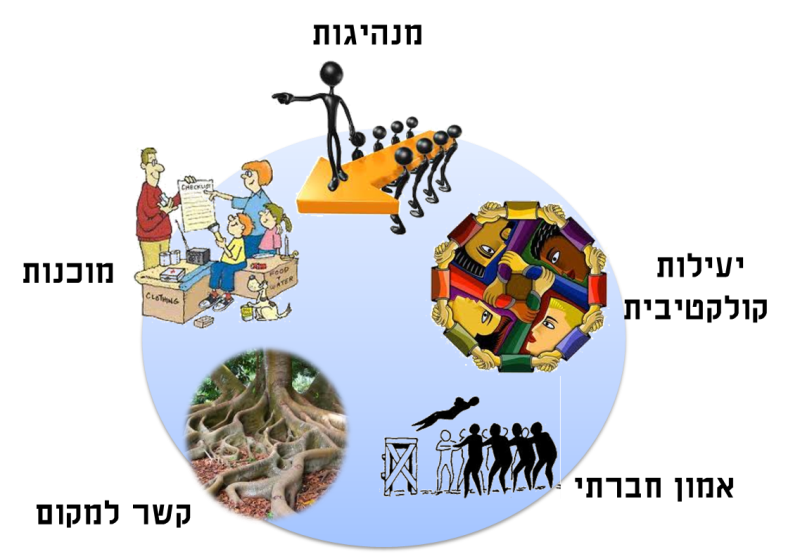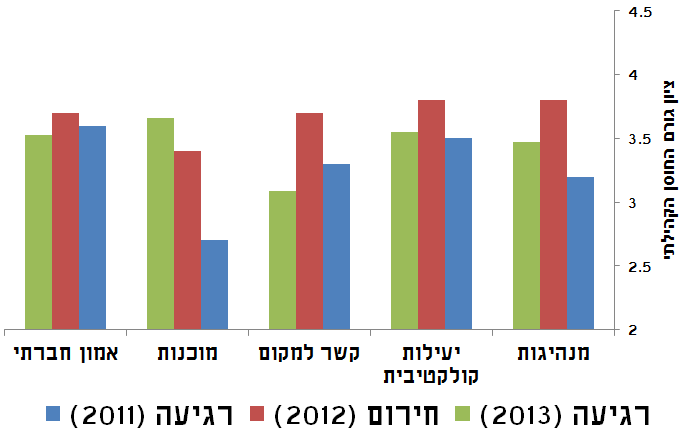
הכלי לאמידת החוסן הקהילתי CCRAM))
Conjoint Community Resiliency Assessment Measure
חוסנה של קהילה הוגדר כיכולתה לתפקד בעת משבר ולחזור לשגרה (גם אם חדשה) ביעילות לאחר אסון.
בשנת 2010 ביוזמת ד"ר לימור אהרנסון-דניאל מאוניברסיטת בן-גוריון בנגב ופרופ' מולי להד מהמכללה האקדמית תל-חי, נפגשו שמונה-עשר מומחי תוכן משבעה מוסדות אקדמיים בישראל ומרקע מגוון, והחלו בתהליך מחקרי מובנה לפיתוח כלי סטנדרטי לאמידה של החוסן הקהילתי בשיתוף מקבלי החלטות ממשרדי ממשלה שונים.
מטרת הכלי היא לתת בידי ראשי קהילות ומקבלי החלטות את היכולת למקד ולכוון משאבים לגורמים שאותרו במחקר כבעלי השפעה על החוסן הקהילתי.
עד כה, הושלמו השלבים שלהלן -
• פותח ותוקף כלי מהימן לאמידת החוסן הקהילתי והסתיימה מדידה ראשונית (בייסליין) של מרכיבי חוסן קהילתי בעשרות ישובים בישראל.
• הכלי הדגים את יכולתו לייצר מדדים וסמנים המבחינים בין קהילות שונות ויכולים לשמש בידי מקבלי החלטות להערכת נקודות חזקות וחלשות בזמן אמת.
• הכלי תורגם לערבית, אנגלית, רוסית, גרמנית, איטלקית ובקרוב יתורגם לספרדית יוונית ותורכית.
• שני מאמרים מרכזיים פורסמו בספרות המקצועית אודות הכלי והשימוש בו. בעקבות הפרסומים עשרות מחקרים ציטטו את הכלי ואת המודל.
השלבים הבאים במחקר -
(1) לחקור את הקשר בין מדד ה-CCRAM לבין כלים, סולמות ומדדים מתוקפים אחרים.
(2) להרחיב את השימוש בכלי ולמדוד חוסן קהילתי בישובים נוספים.
להגשת בקשה לשימוש בשאלון CCRAM נא ללחוץ כאן
ממצאים ראשונים ממחקר החלוץ:
הנחות היסוד של מקבלי החלטות בישראל ובעולם הן ש"חולשות" (להבדיל מחוסן) מבוססות בין היתר על גורמים כגון רמת הכנסה ומעמד תעסוקתי. תכניות, כספים ומאמצים רבים מושקעים בכיוון זה, אולם, כאשר מדובר בחוסן קהילתי ועמידה בפני מצב אסון, המחקר מראה שהמצב שונה והדברים המשפיעים על החוסן הם: מספר שנות מגורים בקהילה, מספר חשיפות קודמות לאירועי חירום והשתייכות לצוות חירום יישובי. גורמי החוסן שנמצאו במחקר הינם:

פרופיל החוסן הקהילתי מאפשר אבחנה בין חוסנם של ישובים שונים או חוסנו של אותו הישוב כעבור זמן ונותן את האפשרות לזהות אילו ממרכיבי החוסן נחלשו או התחזקו. לדוגמא – בתרשים שלהלן ניתן לראות כי בישוב שנבדק לפני, בעת ושנה לאחר מבצע "עמוד ענן" כל מרכיבי החוסן הקהילתי השתפרו במהלך מצב החירום באופן מובהק למעט האמון החברתי שלא הושפע באופן מובהק מהעימות. שנה לאחר מכן, שלושה גורמי חוסן חזרו לרמה הממוצעת לפני מצב החירום, בעוד גורם המוכנות המשיך להשתפר גם שנה לאחר המבצע.

לקהילות יש את הפוטנציאל לתפקד ביעילות ולהסתגל בהצלחה למציאות חדשה לאחר אסון. אמידה תקופתית של החוסן הקהילתי, גם בעת רגיעה, תסייע לחיזוק המוכנות ותמקד את המשאבים בתמיכה בנקודות המחלישות את החוסן ובשעת חירום לאמוד את הנקודות שמחייבות תמיכה והתערבות.
פרוייקט זה מציע כלי מדידה מתוקף לאמידת החוסן הקהילתי. הכלי תורגם לערבית, רוסית ואנגלית ומוכן לשימוש למיפוי החוסן בקהילות. קיים גם שאלון מקוצר תקף בן עשרה פריטים אותו ניתן לצרף לשאלונים אחרים.
חוקרים,
אנו קוראים לכם להצטרף אלינו ולהרחיב את השימוש בכלי בשני כיוונים:
(1) אמידת החוסן הקהילתי בישובים נוספים וצירופם למאגר הלאומי.
(2) הרצת מחקרים בעזרת ה-CCRAM, עם כלים ומשתנים אחרים, על מנת ללמוד על הקשר בין הכלי החדש לכלים ותיקים ואחרים.
ראש רשות,
נשמח לעניין אותך בקיום סקר חוסן ברשות שלך ובהמשך לקיים מדידות עיתיות אשר תסייענה בבחינת יעילות התכניות המופעלות ברשות, לפני, בעת ולאחר שעת חירום.
ניתן לתאם מפגש בו נציג את הכלי ויישומיו ולבחינת ההיבטים המעשיים של הפעלת הפרויקט
לתיאום מפגש: פרופ' לימור אהרנסון-דניאל limorad@bgu.ac.il
פרופ' מולי להד lahadm@netvision.net.il
להגשת בקשה לשימוש בשאלון CCRAM נא ללחוץ כאן
The CCRAM was developed through the collaboration of a group of researchers from seven academic institutions and several governmental authorities in Israel . Members are: Adini Bruria, Aharonson-Daniel Limor, Billig Miriam, Braun-Lewinson Orna, Canneti Daphna, Cohen Odeya, Feder-Bubis Paula, Goldberg Avishay, Israeli Avi, Kimhi Shaul, Lahad Mooli, Leykin Dima, Lissitsa Sabina, Sender Avi, Peres Yochanan, Rappaport Carmit, Sagy Shifra, Shamai Michal.
רשימה מלאה של פרסומי ה CCRAM
Aharonson-Daniel L, Lahad M, Hobfoll SE, Goral A, Leykin D, Canetti D. The relationship between COR and the CCRAM (Conjoint Community Resiliency Assessment Measure). 36th Annual Conference of the Stress and Anxiety Research Society (STAR). 2015.
Aharonson-Daniel L, Lahad M, Leykin D, Cohen O, Goldberg A. Community Resilience Assessment - Meeting the Challenge - the Development of the Conjoint Community Resiliency Assessment. Resiliency: Enhancing Coping with Crisis and Terrorism. 2015. pp. 179–205.
Alshehri, S. A., Rezgui, Y., & Li, H. (2015). Disaster community resilience assessment method: a consensus-based Delphi and AHP approach. Natural Hazards, 78(1), 395-416.
Bonanno, G. A., Romero, S. A., & Klein, S. I. (2015). The temporal elements of psychological resilience: An integrative framework for the study of individuals, families, and communities. Psychological Inquiry, 26(2), 139-169.
Braun-Lewensohn, O., & Mosseri Rubin, M. (2014). Personal and communal resilience in communities exposed to missile attacks: Does intensity of exposure matter?. The Journal of Positive Psychology, 9(2), 175-182.
Braun-Lewensohn, O., & Sagy, S. (2014). Community resilience and sense of coherence as protective factors in explaining stress reactions: comparing cities and rural communities during missiles attacks. Community mental health journal, 50(2), 229-234.
Cline, R. J., Orom, H., Chung, J. E.,& Hernandez, T. (2014). The Role of Social Toxicity in Responses to a Slowly‐Evolving Environmental Disaster: The Case of Amphibole Asbestos Exposure in Libby, Montana, USA. American journal of community psychology, 54(1-2), 12-27.
Cohen, O., Bolotin, A., Lahad, M., Goldberg, A., & Aharonson-Daniel, L. (2016). Increasing sensitivity of results by using quantile regression analysis for exploring community resilience. Ecological Indicators, 66, 497-502.
Cohen, O., Geva, D., Lahad, M., Bolotin, A., Leykin, D., Goldberg, A., & Aharonson-Daniel, L. (2016). Community Resilience throughout the Lifespan–The Potential Contribution of Healthy Elders. PLoS one, 11(2), e0148125.
Cohen, O., Leykin, D., Lahad, M., Goldberg, A., & Aharonson-Daniel, L. (2013). The conjoint community resiliency assessment measure as a baseline for profiling and predicting community resilience for emergencies. Technological Forecasting and Social Change, 80(9), 1732-1741.
Cutter, S. L. (2016). The landscape of disaster resilience indicators in the USA.Natural Hazards, 80(2), 741-758.
Distelberg, B. J., Martin, A. V. S., Borieux, M., & Oloo, W. A. (2015). Multidimensional Family Resilience Assessment: The Individual, Family, and Community Resilience (IFCR) Profile. Journal of Human Behavior in the Social Environment, 25(6), 552-570.
Docena, P. S. (2015). Adaptive Coping, Resilience, and Absence of Anxiety Among Displaced Disaster Survivors. PHILIPPINE JOURNAL OF PSYCHOLOGY, 48(2), 27-49.
Doğulu, C., Karanci, A. N., & Ikizer, G. (2016). How do survivors perceive community resilience? The case of the 2011 earthquakes in Van, Turkey.International Journal of Disaster Risk Reduction, 16, 108-114.
Doğulu, C., Karanci, A. N., & Ikizer, G. (2016). International Journal of Disaster Risk Reduction.
Eshel, Y., & Kimhi, S. (2016). Community resilience of civilians at war: a new perspective. Community mental health journal, 52(1), 109-117.
Eshel, Y., & Kimhi, S. (2016). Determinants of individual resilience following missile attacks: A new perspective. Personality and Individual Differences, 95, 190-195.
Eshel, Y., Kimhi, S., Lahad, M.,& Leykin, D. (2016). Individual, Community, and National Resiliencies and Age: Are Older People Less Resilient than Younger Individuals?. The American Journal of Geriatric Psychiatry.
Henry, D., Gorman-Smith, D., Schoeny, M., & Tolan, P. (2014). “Neighborhood matters": Assessment of neighborhood social processes. American journal of community psychology, 54(3-4), 187-204.
Houston, J. B. (2015). Bouncing Forward Assessing Advances in Community Resilience Assessment, Intervention, and Theory to Guide Future Work.American Behavioral Scientist, 59(2), 175-180.
Jianbo, Z., & Qun, Y. (2014). Design of Public Regional Emergency Communication System based on RS485. Electrotehnica, Electronica, Automatica, 62(3), 126.
Kimhi, S. (2016). Levels of resilience: Associations among individual, community, and national resilience. Journal of health psychology, 21(2), 164-170.
Kimhi, S., & Eshel, Y. (2015). The Missing Link in Resilience Research.Psychological Inquiry, 26(2), 181-186.
Komac, B., & ci ja Lapuh, L. (2014). NEKAJ MISLI O KONCEPTU PROŽNOSTI V GEOGRAFIJI NARAVNIH NESREČ. Geografski vestnik 86-1
Kovalenko, S., Siryk, A., & Vlasiuk, I. (2014). Planning of elimination of emergency consequences. Ukrainian food journal, (3, Issue 2), 288-294.
Kulig, J., & Botey, A. P. Facing a wildfire: What did we learn about individual and community resilience?. Natural Hazards, 1-11.
Labaka, L., Hernantes, J., & Sarriegi, J. M. (2016). A holistic framework for building critical infrastructure resilience. Technological Forecasting and Social Change, 103, 21-33.
Leykin, D., Lahad, M., Cohen, O., Goldberg, A., & Aharonson-Daniel, L. (2013). Conjoint Community Resiliency Assessment Measure‐28/10 Items (CCRAM28 and CCRAM10): A Self‐report Tool for Assessing Community Resilience.American journal of community psychology, 52(3-4), 313-323.
Leykin, D., Lahad, M., Cohen, R., Goldberg, A., & Aharonson-Daniel, L. (2016). The dynamics of Community Resilience between routine and emergency situations. International Journal of Disaster Risk Reduction.
Lyons, A., Fletcher, G., & Bariola, E. (2016). Assessing the Well-Being Benefits of Belonging to Resilient Groups and Communities: Development and Testing of the Fletcher-Lyons Collective Resilience Scale (FLCRS).
Ostadtaghizadeh, A. Ostadtaghizadeh A, Ardalan A, Paton D, Jabbari H, Khankeh HR. Community Disaster Resilience: a Systematic Review on Assessment Models and Tools. PLOS Currents Disasters. 2015 Apr 8. Edition 1. doi: 10.1371/currents. dis. f224ef8efbdfcf1d508dd0de4d8210ed.
Ostadtaghizadeh, A., Ardalan, A., Paton, D., Jabbari, H., & Khankeh, H. R. (2015). Community disaster resilience: a systematic review on assessment models and tools. PLoS currents, 7.
Pérez, J. I. R. (2015). Resiliencia comunitaria: propuesta de una escala y su relación con indicadores de violencia criminal. Pensamiento Psicológico, 13(1), 119-135.
Ruiz Pérez, J. I. (2015). Community Resilience: Proposal of a Scale and its Relationship with Criminal Violence Indicators. Pensamiento Psicológico, 13(1), 119-135.
Sharma, S., & Sharma, S. K. (2015). Psychometric Evaluation of BRT-13B: A Shorter Version of the Benchmark Resilience Tool. Prabandhan: Indian Journal of Management, 8(3), 33-47.
Sharma, S., & Sharma, S. K. (2016). Team Resilience: Scale Development and Validation. Vision, 20(1), 37.
Singh-Peterson, L., Salmon, P., Baldwin, C., & Goode, N. (2015). Deconstructing the concept of shared responsibility for disaster resilience: a Sunshine Coast case study, Australia. Natural Hazards, 79(2), 755-774.
Singh-Peterson, L., Salmon, P., Goode, N., & Gallina, J. (2014). Translation and evaluation of the baseline resilience indicators for communities on the Sunshine Coast, Queensland Australia. International journal of disaster risk reduction, 10, 116-126.
Storr, V. H., Haeffele-Balch, S.,& Grube, L. E. (2015). Community Revival in the Wake of Disaster: Lessons in Local Entrepreneurship. Palgrave Macmillan.
Turoff, M., Hiltz, S. R., Bañuls, V. A., & Van Den Eede, G. (2013). Multiple perspectives on planning for emergencies: An introduction to the special issue on planning and foresight for emergency preparedness and management.Technological Forecasting and Social Change, 80(9), 1647-1656.
Коваленко, С. Д., Коваленко, С. Д., Сірик, А. О., Сирик, А. О., Siryk, A., Власюк, І., ... & Kovalenko, S. D. (2014). Planning of elimination of emergency consequences.